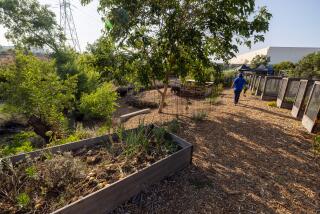‘Earth’ and ‘Sky’ Will Be Moving on Command for Torrance Pupils
- Share via
Ian Mikelson, a 9-year-old student from Riviera Elementary School, sat cross-legged in the dark waiting for something to happen.
Then, slowly the lights grew dim and stars appeared. Hundreds of them. The grouping of stars that form the Little Dipper shone to his right. The full moon glowed silver over his left shoulder.
“Oooooh,” remarked Ian, a blond boy in shorts. “Neat-o.”
As genuine as the reaction was, the stars were not. They were created inside an inflatable planetarium called Starlab, which was purchased this summer by the Torrance Unified School District.
The $10,000 planetarium is the main attraction in the district’s new science center at the Levy Curriculum Center. The science center was financed through a $167,480 grant from the U.S. Department of Education and includes computers, a laser-disc player, and machines that demonstrate lasers, optics and land erosion.
The grant, one of 31 given to school districts throughout the nation, is intended to promote the study of math and science, according to Lucille LeMiex, a Torrance curriculum consultant, who wrote the grant application.
“Teachers have ‘technophobia,’ ” LeMiex said. “This is to encourage them to teach and learn more math and science.”
The center will officially open on Sept. 11 and will be available to students from all public and private schools in Torrance, she said.
So far, the only Torrance students to experience Starlab have been some of those attending English as a Second Language courses at Levy this summer, and Ian and a group of friends who happened to be playing soccer nearby when the planetarium was being demonstrated.
By gauging the reaction from those who have seen Starlab, school officials think it’s going to be hotter than a supernova.
“It’s a tremendous little thing,” said Bill Paloney, a science teacher at Magruder Middle School.
The planetarium, which resembles a huge silver wart, is 10 feet tall and 15 feet wide. It is made of a plastic sheet-like material and is inflated with a regular three-speed house fan. Up to 32 people can fit inside. The images shone on the walls of the planetarium are created by a small rotating projector that sits on a box in the middle of the dome.
But astronomy is not the only subject that can be taught using Starlab, Paloney said. By changing the cylindrical film that fits over the projector, Paloney said he can teach biology by projecting diagrams of a cell, or geography by showing maps of the Earth’s plates.
“There are things you cannot teach somebody or show somebody without using something like this,” Paloney said.
He said he can even teach history with a film that shows a world map and outlines battle strategies used during World War II.
But the images that impressed Ian and his soccer pals the most were the signs of the zodiac, which were shone in different colors on the ceiling of the dome.
“Wow, cool,” said one boy.
“Hey, what’s that?” asked another.
“Is Pisces up there?” asked a young girl.
“The fish? Yeah, they’re right there,” said Paloney, as he pointed with a flashlight.
When the show was over, Ian summed up his thoughts about Starlab simply: “I like it.”
Then he strapped on his cleats and ran back to the soccer field.
More to Read
Sign up for Essential California
The most important California stories and recommendations in your inbox every morning.
You may occasionally receive promotional content from the Los Angeles Times.











